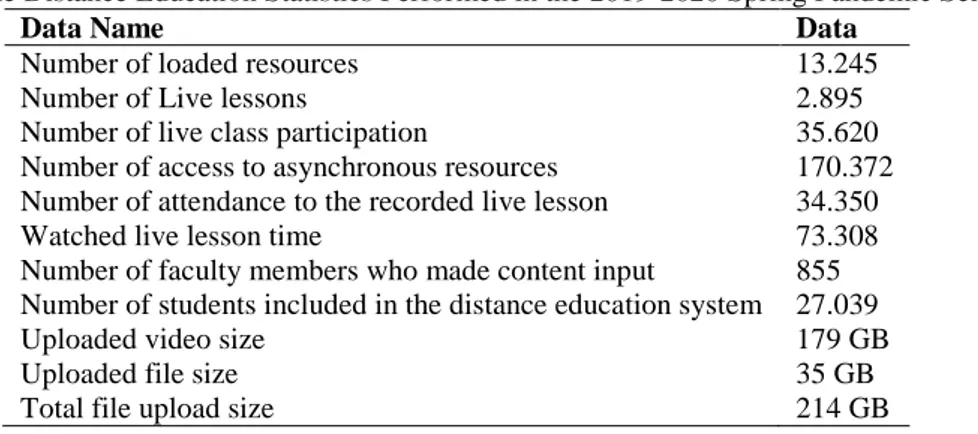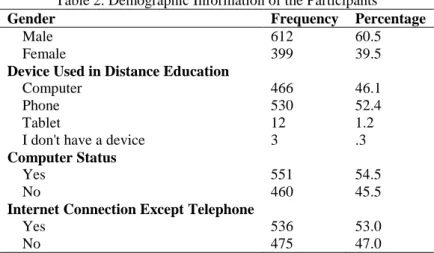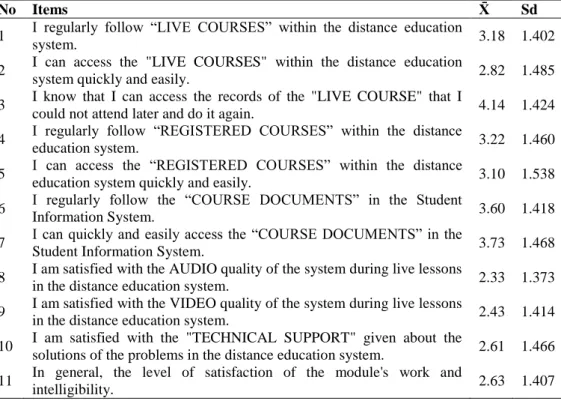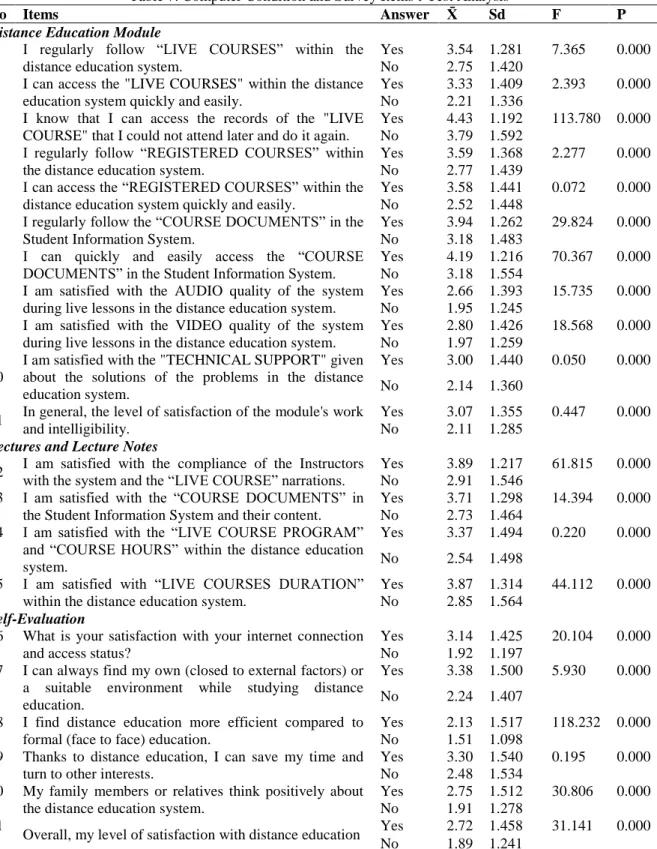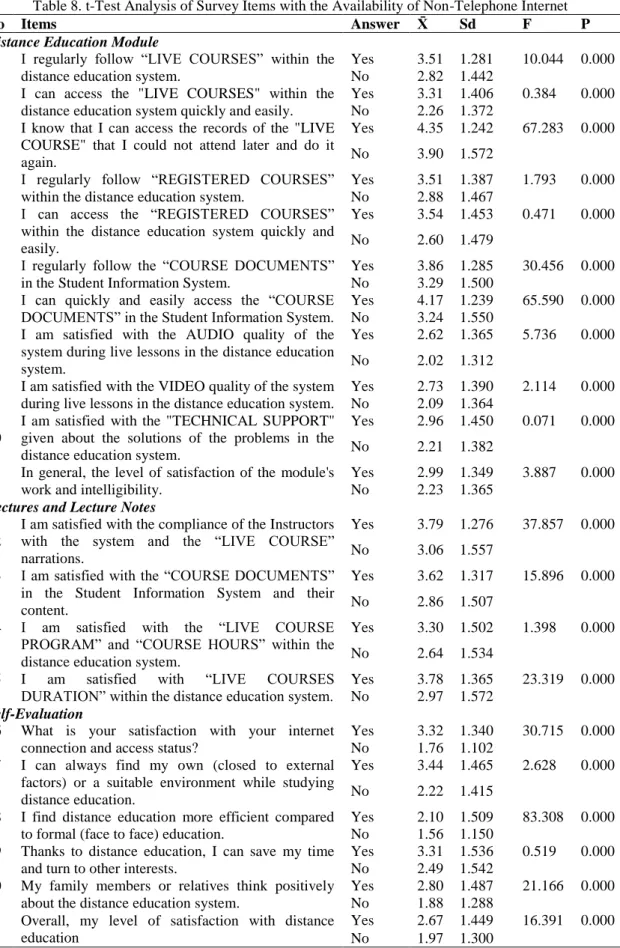www.ijtes.net
Distance Education in Higher Education
in the COVID-19 Pandemic Process: A
Case
of
Isparta
Applied
Sciences
University
Ebru Yilmaz İnce, Ahmet Kabul, İbrahim Diler
Isparta University of Applied Sciences, Turkey
To cite this article:
Yılmaz İnce, E., Kabul, A., & Diler, İ. (2020). Distance education in higher education in the
COVID-19 pandemic process: A case of Isparta Applied Sciences University.
International
Journal of Technology in Education and Science (IJTES), 4(4), 343-351.
Distance Education in Higher Education in the COVID-19 Pandemic
Process: A Case of Isparta Applied Sciences University
Ebru Yılmaz İnce, Ahmet Kabul, İbrahim Diler
Article Info
Abstract
Article History
Received: 11 May 2020
Distance education is an education model where individuals are free from learning resources and have no time constraints. During the pandemic period, Isparta University of Applied Sciences continued its 2019-2020 Academic Year Spring semester with distance education with asynchronous lecture notes and synchronous live courses. The purpose of this research is to determine the knowledge and views of students about distance education in the Pandemic Process. Survey method was used in the research; the participants of the research were 1011 students are students at Isparta University of Applied Sciences during the COVID-19 pandemic process. In order to collect the data, a 5-point Likert questionnaire with 21 items was applied. The average, standard deviation and t-Test analysis of the data were done in the SPSS program. According to the results of this research, it was determined that the opportunities of the participants as having computer and internet affect their views on distance education.
Accepted: 27 August 2020
Keywords
Distance education COVID-19 Pandemic Survey
Introduction
Distance education is an education model where individuals are free from learning resources and have no time limitation. Current developments in information technologies have helped the development of the global communication network with distance education applications. Communication has become an inevitable need for individuals living in the transmitted message. It has been made available on the internet today.
Al and Madran (2004) stated the features of web-based distance education systems as identifying and managing users, preparing course contents, managing courses, opening student-specific programs, homework and project submission/delivery, preparation and implementation of exams and tests, monitoring and examining student behavior, assessment of student success and interactive communication environments establishment and management. Every institution that provides distance education has the obligation to fulfill these features. Also distance education must meet different learning styles, so Costa et al. (2020) used some artificial intelligence algorithms to identify the relation of the students‟ learning styles with their behaviors in learning management system.
There are many studies on the possibilities and problems of distance education in the relevant literature. Valentine (2002) stated that despite being advantages of distance learning, there are problems that need to be resolved as the quality of instruction, hidden costs, misuse of technology, and the attitudes of instructors, students, and administrators. There are advantages of distance learning as enhances learning opportunities, improves learning outcomes and facilitates networking and collaboration; and disadvantages as lack of social interaction or participation, may cause a feeling of isolation, while absence of social atmosphere may minimize motivation and interaction and worsen discipline (Ainoutdinova et al., 2017). Mirkholikovna (2020) stated the advantages of distance learning as Availability, flexibility and relatively economy of money and time and gives a person a specific set of knowledge and skills, and disadvantages of distance learning as limited choice of faculties/modules and limited private communication.
344 Yılmaz İnce, Kabul, & Diler
in a composite material course and determined that distance students again reported lower confidence in their understanding of course concepts.
The existence of many positive and sometimes critical approaches about distance education will not affect the use of this education in some special cases. After the COVID-19 epidemic in 2020, it made the distance education model compulsory without space limitation and was used in many countries at all levels of education (Bansal, 2020; Setiawan, 2020). COVID-19 pandemic opened up opportunities to the country to upgrade its educational mode and transfer its attention to emerging technologies (Toquero, 2020). Crawford et al. (2020) studied 20 countries' higher education intra-period digital pedagogy responses to discuss university responses across the world and determined that one side of extreme universities did little to respond (e.g. social distance), most of the universities rapidly closed their face-to-face operations and moved to digitalized education, and some universities were already prepared blended or fully online offerings before pandemic.
During the COVID-19 pandemic process, the rapid transition to online education in higher education has forced the development of instructional strategy. Bao (2020) stated that the COVID‐ 19 caused Chinese universities to close the campuses and forced them to initiate online teaching, and for summarizing current online teaching experiences for university instructors six specific instructional strategies are presented, as “high relevance between online instructional design and student learning”, “effective delivery on online instructional information”, “adequate support provided by faculty and teaching assistants to students”; “high ‐ quality participation to improve the breadth and depth of student's learning”, and “contingency plan to deal with unexpected incidents of online education platforms”.
10 In March 2020, COVID-19 pandemic was announced by Republic of Turkey Ministry of Health. On March 12, the Higher Education Council announced that the formal education at universities was suspended as of March 16, 2020. Within the scope of COVID-19 measures, universities decided to apply the distance education model in the Spring semester of 2019-2020 Academic Year, by taking a senate decision.
Isparta University of Applied Sciences has started distance education with asynchronous course documents from March 23, 2020. Isparta University of Applied Sciences, which started synchronous courses as of March 30 has enabled students to continue their education with a distance education model during the pandemic process. Table 1 shows the distance education statistics performed in the 2019-2020 Spring Pandemic Semester, as number of loaded resources, number of live lessons, number of live class participants, number of access to asynchronous resources, number of attendance to the recorded live lesson, watched live lesson time, number of faculty members who made content input, number of students included in the distance education system, uploaded video size, uploaded file size and total file upload size.
Table 1. The Distance Education Statistics Performed in the 2019-2020 Spring Pandemic Semester
Data Name Data
Number of loaded resources 13.245
Number of Live lessons 2.895
Number of live class participation 35.620
Number of access to asynchronous resources 170.372 Number of attendance to the recorded live lesson 34.350
Watched live lesson time 73.308
Number of faculty members who made content input 855 Number of students included in the distance education system 27.039
Uploaded video size 179 GB
Uploaded file size 35 GB
Total file upload size 214 GB
Method
In this research, distance education in higher education in COVID-19 pandemic process is discussed the case of Isparta University of Applied Sciences. The survey method is defined as “arrangements made in the whole universe or a group of samples or samples to be taken from it in order to reach a general judgment about the universe” (Karasar, 2008). In this study, the opinions of students about distance education performed in the COVID-19 pandemic process using the survey method are presented.
The study was carried out with the participation of Isparta University of Applied Sciences students during the Spring Semester Pandemic Period of 2019-2020. Volunteering and availability principles were taken as basis in determining the participants. A total of 1011 people, 612 of whom were Men (60.5%) and 399 were Women (39.5%), answered the questionnaire (see Table 2).
Table 2. Demographic Information of the Participants
Gender Frequency Percentage
Male 612 60.5
Female 399 39.5
Device Used in Distance Education
Computer 466 46.1
Phone 530 52.4
Tablet 12 1.2
I don't have a device 3 .3
Computer Status
Yes 551 54.5
No 460 45.5
Internet Connection Except Telephone
Yes 536 53.0
No 475 47.0
Participants were asked about the device they preferred to use in distance education, and it was determined that the participants used 466 computers (46.1%) and 530 phones (52.4%) as devices. "Is there a computer that you can use separately even if you can access the distance education system over the phone?" question was asked, 551 participants answered this question as yes (54.5%). "Do you have an Internet connection except your phone Internet at home right now for access to the distance education system?" 536 of the students answered yes (53%) to the question.
In this study, the questionnaire questions were prepared by examining the survey studies prepared in this field and by taking the opinions of three experts who are experienced in distance education. At this stage, after the draft questionnaire questions were prepared, the questionnaire was conducted face-to-face with 10 people in order to improve the questionnaire, to eliminate possible problems and deficiencies in the process and to reach the targeted result reliably. After this application, the errors in the survey questions have been corrected and the necessary additions and deductions have been made and the survey questions have been finalized.
There are 21 items in the questionnaire, these items are represented by 3 themes: "distance education system", "lectures and lecture notes" and "personal evaluation", which were developed in order to examine students' views on distance education. The scale has a Cronbach Alpha reliability coefficient of 0.909 and was created using a 5-point Likert type. Average, standard deviation and t-test analyzes were performed in the SPSS program. The responses to the scale items were evaluated by using mean, standard deviation, frequency, percentage and t-test analyzes. The 5-point Likert scale used is an evaluation scale from 1 to 5, and the scale options and score ranges are given in Table 3 (Karadağ et al., 2008).
Table 3. Scale Options and Score Ranges
Options Scale options Score ranges
I totally agree 5 4.20–5.00
I agree 4 3.40–4.19
Undecied 3 2.60–3.39
346 Yılmaz İnce, Kabul, & Diler
Results and Discussion
The 21-item survey conducted within the scope of this study was represented by 3 factors: “distance education module”, “lectures and lecture notes” and “personal evaluation”, and the findings are presented in these titles. Also, t test analysis is performed for computer and internet status of participants.
Distance Education Module
Before the start of the 2019-2020 Spring Semester Pandemic Period of Isparta University of Applied Sciences, faculty members uploaded the course documents to the Student Information System. In order to provide technical information about the processing of distance education, information guides were prepared for academicians and students, and published on the University website. Within the scope of distance education, all courses were processed with live course links in accordance with the 2019-2020 Spring Semester Course Schedule, and the taught courses were recorded in the registered courses category, so that students can access the course again.
There are 11 questionnaires about distance education documents and live lessons that participants can access via the Student Information System (see Table 3). Given the average values of the survey items, the participants said, “I know that I can access the records of the "LIVE COURSE" that I could not attend later and do it again.” (X = 4.14), “I can quickly and easily access the “COURSE DOCUMENTS” in the Student Information System.” (X = 3.73) and “I regularly follow the “COURSE DOCUMENTS” in the Student Information System.” (X = 3.60) answered the questionnaire at the level I agree. In addition, hard copies of the course documents were sent to students without internet access.
While students are satisfied in accessing the course documents and accessing registered and live classes; They stated that they were not satisfied with the quality of video (X = 2.43) and sound (X = 2.33) of system during live lessons in the distance education system (seeTable 4). The students were informed about the internet and device quality, and the students were informed about the internet and device quality, users are informed about the audio and camera optimizations that should be done when the internet speed slow down. Part of this problem has been solved with the fact that the courses can be followed by the courses registered in the student information system.
Table 4. Questionnaire Items about Distance Education Module
No Items Sd
1 I regularly follow “LIVE COURSES” within the distance education
system. 3.18 1.402
2 I can access the "LIVE COURSES" within the distance education
system quickly and easily. 2.82 1.485
3 I know that I can access the records of the "LIVE COURSE" that I
could not attend later and do it again. 4.14 1.424
4 I regularly follow “REGISTERED COURSES” within the distance
education system. 3.22 1.460
5 I can access the “REGISTERED COURSES” within the distance
education system quickly and easily. 3.10 1.538
6 I regularly follow the “COURSE DOCUMENTS” in the Student
Information System. 3.60 1.418
7 I can quickly and easily access the “COURSE DOCUMENTS” in the
Student Information System. 3.73 1.468
8 I am satisfied with the AUDIO quality of the system during live lessons
in the distance education system. 2.33 1.373
9 I am satisfied with the VIDEO quality of the system during live lessons
in the distance education system. 2.43 1.414
10 I am satisfied with the "TECHNICAL SUPPORT" given about the
solutions of the problems in the distance education system. 2.61 1.466 11 In general, the level of satisfaction of the module's work and
Lectures and Lecture Notes
The 4 questionnaires about live lectures and lecture notes academicians uploaded to the student information system, are presented in Table 5. The participants stated that they are satisfied with the compliance of the Instructors with the system and the “LIVE COURSE” narrations (X = 3.44) and live courses duration (X = 3.40).
Table 5. Questionnaires about Lectures and Lecture Notes
No Items Sd
12 I am satisfied with the compliance of the Instructors with the system and the “LIVE COURSE” narrations. 3.44 1.461 13 I am satisfied with the “COURSE DOCUMENTS” in the Student Information
System and their content. 3.26 1.459
14 I am satisfied with the “LIVE COURSE PROGRAM” and “COURSE HOURS”
within the distance education system. 2.99 1.552
15 I am satisfied with “LIVE COURSES DURATION” within the distance
education system. 3.40 1.520
Self-Evaluation
In this part of the survey, students have personal assessments about their own opportunities. “I find distance education more efficient compared to formal (face to face) education.” (X = 1.85) item has the lowest average (see Table 6). When participants compared formal education and distance education, it was determined that they thought formal education was more efficient. In addition, the satisfaction level of the participants and family members who studied in formal education and encountered distance education during the pandemic process “Overall, my level of satisfaction with distance education” (X = 2.34) and “My family members or relatives think positively about the distance education system.” (X = 2.37) is lower than the answers given to the items. “What are you satisfied with your internet connection and access status?” (X = 2.59) is at the limit of disagree. One reason why internet satisfaction is low is that the internet is used a lot throughout the country in the pandemic process (Ting et al., 2020). Therefore, the internet satisfaction used by the user, which is one of the most important factors for the realization of distance education, is low. The students said, "I can always find my own (closed to external factors) or a suitable environment while studying distance education." (X = 2.86) and “Thanks to distance education, I can save my time and turn to my other interests.” (X = 2.93), the items are at the level of indecision.
Table 6. Questionnaire Items about Self-evaluation
No Items Sd
16 What is your satisfaction with your internet connection and access status? 2.59 1.459 17 I can always find my own (closed to external factors) or a suitable environment
while studying distance education. 2.86 1.564
18 I find distance education more efficient compared to formal (face to face)
education. 1.85 1.377
19 Thanks to distance education, I can save my time and turn to other interests. 2.93 1.591 20 My family members or relatives think positively about the distance education
system. 2.37 1.470
21 Overall, my level of satisfaction with distance education 2.34 1.424
Computer Condition
348 Yılmaz İnce, Kabul, & Diler
Table 7. Computer Condition and Survey Items t-Test Analysis
No Items Answer Sd F P
Distance Education Module
1 I regularly follow “LIVE COURSES” within the distance education system.
Yes 3.54 1.281 7.365 0.000 No 2.75 1.420
2 I can access the "LIVE COURSES" within the distance education system quickly and easily.
Yes 3.33 1.409 2.393 0.000 No 2.21 1.336
3 I know that I can access the records of the "LIVE COURSE" that I could not attend later and do it again.
Yes 4.43 1.192 113.780 0.000 No 3.79 1.592
4 I regularly follow “REGISTERED COURSES” within the distance education system.
Yes 3.59 1.368 2.277 0.000 No 2.77 1.439
5 I can access the “REGISTERED COURSES” within the distance education system quickly and easily.
Yes 3.58 1.441 0.072 0.000 No 2.52 1.448
6 I regularly follow the “COURSE DOCUMENTS” in the Student Information System.
Yes 3.94 1.262 29.824 0.000 No 3.18 1.483
7 I can quickly and easily access the “COURSE DOCUMENTS” in the Student Information System.
Yes 4.19 1.216 70.367 0.000 No 3.18 1.554
8 I am satisfied with the AUDIO quality of the system during live lessons in the distance education system.
Yes 2.66 1.393 15.735 0.000 No 1.95 1.245
9 I am satisfied with the VIDEO quality of the system during live lessons in the distance education system.
Yes 2.80 1.426 18.568 0.000 No 1.97 1.259
10
I am satisfied with the "TECHNICAL SUPPORT" given about the solutions of the problems in the distance education system.
Yes 3.00 1.440 0.050 0.000 No 2.14 1.360
11 In general, the level of satisfaction of the module's work and intelligibility.
Yes 3.07 1.355 0.447 0.000 No 2.11 1.285
Lectures and Lecture Notes
12 I am satisfied with the compliance of the Instructors with the system and the “LIVE COURSE” narrations.
Yes 3.89 1.217 61.815 0.000 No 2.91 1.546
13 I am satisfied with the “COURSE DOCUMENTS” in the Student Information System and their content.
Yes 3.71 1.298 14.394 0.000 No 2.73 1.464
14 I am satisfied with the “LIVE COURSE PROGRAM” and “COURSE HOURS” within the distance education system.
Yes 3.37 1.494 0.220 0.000 No 2.54 1.498
15 I am satisfied with “LIVE COURSES DURATION” within the distance education system.
Yes 3.87 1.314 44.112 0.000 No 2.85 1.564
Self-Evaluation
16 What is your satisfaction with your internet connection and access status?
Yes 3.14 1.425 20.104 0.000 No 1.92 1.197
17 I can always find my own (closed to external factors) or a suitable environment while studying distance education.
Yes 3.38 1.500 5.930 0.000 No 2.24 1.407
18 I find distance education more efficient compared to formal (face to face) education.
Yes 2.13 1.517 118.232 0.000 No 1.51 1.098
19 Thanks to distance education, I can save my time and turn to other interests.
Yes 3.30 1.540 0.195 0.000 No 2.48 1.534
20 My family members or relatives think positively about the distance education system.
Yes 2.75 1.512 30.806 0.000 No 1.91 1.278
21
Overall, my level of satisfaction with distance education Yes 2.72 1.458 31.141 0.000 No 1.89 1.241
Internet Condition
involved in all the items. It was determined that the participants' having internet expect the phone affects their opinions about distance education.
Table 8. t-Test Analysis of Survey Items with the Availability of Non-Telephone Internet
No Items Answer Sd F P
Distance Education Module
1 I regularly follow “LIVE COURSES” within the distance education system.
Yes 3.51 1.281 10.044 0.000
No 2.82 1.442
2 I can access the "LIVE COURSES" within the distance education system quickly and easily.
Yes 3.31 1.406 0.384 0.000
No 2.26 1.372
3
I know that I can access the records of the "LIVE COURSE" that I could not attend later and do it again.
Yes 4.35 1.242 67.283 0.000
No 3.90 1.572
4 I regularly follow “REGISTERED COURSES” within the distance education system.
Yes 3.51 1.387 1.793 0.000
No 2.88 1.467
5
I can access the “REGISTERED COURSES” within the distance education system quickly and easily.
Yes 3.54 1.453 0.471 0.000
No 2.60 1.479
6 I regularly follow the “COURSE DOCUMENTS” in the Student Information System.
Yes 3.86 1.285 30.456 0.000
No 3.29 1.500
7 I can quickly and easily access the “COURSE DOCUMENTS” in the Student Information System. Yes 4.17 1.239 65.590 0.000
No 3.24 1.550
8
I am satisfied with the AUDIO quality of the system during live lessons in the distance education system.
Yes 2.62 1.365 5.736 0.000
No 2.02 1.312
9 I am satisfied with the VIDEO quality of the system during live lessons in the distance education system.
Yes 2.73 1.390 2.114 0.000
No 2.09 1.364
10
I am satisfied with the "TECHNICAL SUPPORT" given about the solutions of the problems in the distance education system.
Yes 2.96 1.450 0.071 0.000
No 2.21 1.382
11 In general, the level of satisfaction of the module's work and intelligibility.
Yes 2.99 1.349 3.887 0.000
No 2.23 1.365
Lectures and Lecture Notes
12
I am satisfied with the compliance of the Instructors with the system and the “LIVE COURSE” narrations.
Yes 3.79 1.276 37.857 0.000
No 3.06 1.557
13 I am satisfied with the “COURSE DOCUMENTS” in the Student Information System and their content.
Yes 3.62 1.317 15.896 0.000
No 2.86 1.507
14 I am satisfied with the “LIVE COURSE PROGRAM” and “COURSE HOURS” within the distance education system.
Yes 3.30 1.502 1.398 0.000
No 2.64 1.534
15 I am satisfied with “LIVE COURSES DURATION” within the distance education system.
Yes 3.78 1.365 23.319 0.000
No 2.97 1.572
Self-Evaluation
16 What is your satisfaction with your internet connection and access status?
Yes 3.32 1.340 30.715 0.000
No 1.76 1.102
17 I can always find my own (closed to external factors) or a suitable environment while studying distance education.
Yes 3.44 1.465 2.628 0.000
No 2.22 1.415
18 I find distance education more efficient compared to formal (face to face) education.
Yes 2.10 1.509 83.308 0.000
No 1.56 1.150
19 Thanks to distance education, I can save my time and turn to other interests.
Yes 3.31 1.536 0.519 0.000
No 2.49 1.542
20 My family members or relatives think positively about the distance education system.
Yes 2.80 1.487 21.166 0.000
No 1.88 1.288
21 Overall, my level of satisfaction with distance education
Yes 2.67 1.449 16.391 0.000
350 Yılmaz İnce, Kabul, & Diler
Conclusion
This study presents the information and views of students about distance education in the 2019-2020 Education and Spring Semester Pandemic Period. Hung and Wati (2020) stated that the challenge for educators is how to make education in the pandemic more „humane‟ and „embodied‟ by creating a balance between technology use and humanity in education. Keskin and Kaya (2020) has highlighted that assessment of the advantages and disadvantages of emergency structured web-based distance education can be important for seeing the reflections of the period and proper configuration of such trainings in the pandemic period. According to the results of this research that takes students opinions into account, it has been revealed that the participants have internet connection other than computer and telephone in the house of more than half of them, so it should be taken into consideration that the participants are not sufficient and give their opinions about distance education according to these opportunities.
It was determined that the students in the questionnaire participated in the item on the distance education module, where they access the live education documents, live lessons and registered lessons, the records of the most live lessons can be accessed and repeated later. Turchynova et al. (2020) emphasized the comprehensibility, accessibility and repeatability features of distance education in their research. In addition, the participants stated that they are satisfied with the lecturer's compatibility with the system and live lectures and live lessons. When participants compared formal education and distance education, it was determined that they thought formal education was more efficient. When the questionnaires were analyzed by t-test according to having a computer and having a telephone internet, it was determined that the participants' internet and non-telephone internet affects their views of distance education.
The COVID-19 pandemic has not yet ended and the world health organization is now talking about the second wave scenarios of the epidemic. Therefore, most universities will continue their education with distance education during the pandemic process, and this process will lead to changes in education after the pandemic. Murphy (2020) studied COVID-19 and emergency eLearning and claimed that consequences of the securitization of higher education for post-pandemic pedagogy may increase access to education in rural communities due to personal or financial circumstances, the flexibility of asynchronous eLearning may provide wider access, also hybrid or blended forms may help improve the quality of face-to-face teaching by moving content delivery online and focusing in-person sessions on active learning within traditional higher education institutions. Toquero (2020) stated that higher education institutions thereby need to seize the opportunity to strengthen its evidence-based practices, provide accessible mental health-related services, and make the curriculum responsive for pandemic situations such as COVID-19.
References
Ainoutdinova, I. N., Khuziakhmetov, A. N. & Tregubova, T. M. (2017). Advantages and disadvantages of distance education for university students in Russia. Modern Journal of Language Teaching Methods, 7(9/2), 72–86.
Al, U., & Madran, O. (2004). Web tabanlı uzaktan eğitim sistemleri: Sahip olması gereken özellikler ve standartlar. Bilgi Dünyası, 5(2), 259-271.
Bansal, S. (2020). Impact of the COVID-19 pandemic on education, rise of online teaching learning process & effects on health of kids. Rise of Online Teaching Learning Process & Effects on Health of Kids. Retrieved from: https://papers.ssrn.com/sol3/papers.cfm?abstract_id=3595971
Bao, W. (2020). COVID‐ 19 and online teaching in higher education: A case study of Peking University. Human Behavior and Emerging Technologies, 2(2), 113-115.
Cavalli, M. (2017). Comparison of on-campus and distance learning outcomes in a composite materials course. In ASEE Annual Conference and Exposition, ASEE.
Crawford, J., Butler-Henderson, K., Rudolph, J., Malkawi, B., Glowatz, M., Burton, R., ... & Lam, S. (2020). COVID-19: 20 countries' higher education intra-period digital pedagogy responses. Journal of Applied Learning & Teaching, 3(1), 1-20.
Costa, R. D., Souza, G. F., Castro, T. B., Valentim, R. A., & Dias, A. P. (2020). Identification of learning styles in distance education through the interaction of the student with a learning management system. IEEE
Revista Iberoamericana de Tecnologias del Aprendizaje, 15(3),. 148-160.
https://doi.org/10.1109/RITA.2020.3008131
Hung, R., & Wati, U. A. (2020). Digital home schooling during the pandemic: Possibilities and challenges. Knowledge Cultures, 8(2). Retrieved from: https://www.ceeol.com/search/article-detail?id=886347
Karadağ, E., Sağlam, H., & Baloğlu, N. (2008). Bilgisayar Destekli eğitim [BDE]: ilköğretim okulu yöneticilerinin tutumlarına ilişkin bir araştırma. Journal of International Social Research, 1(3), 252-266. Karasar, N. (2008). Bilimsel araştırma yöntemi: kavramlar-ilkeler-teknikler. Nobel Yayın Dağıtım.
Mollenkopf, D., Vu, P., Crow, S., & Black, C. (2017). Does online learning deliver? A comparison of student teacher outcomes from candidates in face-to-face and online program pathways. Online Journal of Distance Learning Administration, 20(1). Retrieved from: https://www.westga.edu/~distance/ojdla/ spring201/mollenkopf_vu_crow_black201.html
Keskin, M., & Kaya, D.Ö. (2020). COVID-19 Sürecinde öğrencilerin web tabanlı uzaktan eğitime yönelik geri bildirimlerinin değerlendirilmesi. Izmir Katip Çelebi Üniversitesi Sağlık Bilimleri Fakültesi Dergisi, 5(2), 59-67.
Mirkholikovna, D. K. (2020). Advantages and disadvantages of distance learning. Наука и образование сегодня, 7(54), 70-72.
Murphy, M. P. (2020). COVID-19 and emergency eLearning: Consequences of the securitization of higher education for post-pandemic pedagogy. Contemporary Security Policy, 41(3), 492-505. https://doi.org/10.1080/13523260.2020.1761749
Setiawan, A. R. (2020). Scientific literacy worksheets for distance learning in the topic of Coronavirus 2019 (COVID-19), Reading Academic Articles. Retrieved from: https://edarxiv.org/swjmk/
Ting, D. S. W., Carin, L., Dzau, V., & Wong, T. Y. (2020). Digital technology and COVID-19. Nature Medicine, 26(4), 459-461.
Toquero, C. M. (2020). Challenges and opportunities for higher education amid the COVID-19 pandemic: The Philippine context. Pedagogical Research, 5(4). https://doi.org/10.29333/pr/7947
Turchynova, G., Hladun, Т., Hnoievska, O., Harashchenko, L., Kozak, L., Rudenko, I., & Tarasova, V. (2020). Entrepreneurship Education of ІT-specialists through distance learning technologies. Journal of Entrepreneurship Education, 23(S1). Retrieved from: http://enpuir.npu.edu.ua/handle/123456789/28102 Valentine, D. (2002). Distance learning: Promises, problems, and possibilities. Online Journal of Distance
Learning Administration, 5(3). Retrieved from: https://www.westga.edu/~distance/ojdla/fall53/ valentine53.html
Author Information
Ebru Yılmaz İnce
Isparta University of Applied Sciences Turkey
Contact e-mail: ebruince@isparta.edu.tr
Ahmet Kabul
Isparta University of Applied Sciences Turkey
İbrahim Diler
